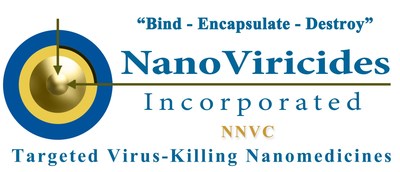Subject: TRI
NanoViricides Reports Its Drug Candidates Significantly Reduced the Extent of Shingles Virus Infection of Human Skin
SHELTON, Conn., July 10, 2017 /PRNewswire/ -- NanoViricides, Inc. (NYSE MKT: NNVC) (the "Company") reports that its anti-shingles nanoviricides® drug candidates achieved dramatic reduction in infection of human skin by the varicella-zoster virus (VZV), the shingles virus. These findings corroborate the previously reported findings of inhibition of VZV infection of human cells in culture. VZV is restricted to human tissue and only infects and replicates in human tissue.

Over the time course of VZV infection, the nanoviricides® drug candidates showed marked inhibition of VZV infection, replication and spread in human skin cultured ex vivo. The data suggest that select nanoviricides® drug candidates may have direct virucidal activity based on their antiviral effects within the first 24 hours after viral infection.
The antiviral effect of certain nanoviricide drug candidates was substantially greater than the effect of the standard positive control of cidofovir added into media. Even more remarkably, the effect of these nanoviricides drug candidates was equivalent to a topical formulation of 1% cidofovir applied directly onto the skin patch. A topical skin cream containing 2% cidofovir is clinically used in very severe cases of shingles. However, the cytotoxicity of cidofovir is known to cause ulceration of the skin to which it is applied, followed by natural wound healing. We are awaiting histopathology studies at present.
Since VZV causes skin lesions as a result of direct attack of the re-awakened virus released from nerve endings onto the human skin cells, this ex vivo human skin patch model involving VZV infection of cultured human skin ex vivo is considered to be a close representation of natural course of shingles.
The Company has previously reported that these same nanoviricides® compounds displayed potent inhibition of VZV infection of a human retinal epithelial pigment cell line in an in vitro cell culture virus infection model with no evidence of toxicity to the cells. These ex vivo and in vitro studies are a critical step in the selection of final clinical drug development candidates for safety and toxicology studies with the goal of an IND submission to the FDA for the topical treatment of shingles in humans.
"These human skin studies provide important validation of our VZV project," stated Dr. Eugene Seymour, MD, MPH, CEO of the Company, "and will expedite our VZV drug development as well as our entire Herpicidetm drug program."
The human skin studies were performed in the laboratory of Dr. Jennifer Moffat at SUNY Upstate Medical University in Syracuse, NY. The Company previously reported the collaboration with Dr. Moffat, an internationally recognized expert on varicella-zoster virus. She has extensive experience in varicella-zoster virus (VZV) infection, pathogenesis, and anti-viral agent discovery. The National Institutes of Health has a contract with Dr. Moffat's lab for evaluating anti-viral compounds against VZV, although the Company chose to set up a direct collaboration with Dr. Moffat rather than going through the NIH program.
"The nanoviricides® compounds we tested in the skin assays showed clear evidence of anti-VZV activity," stated Dr. Moffat, adding, "we are pleased that our results can be used to select the most promising compounds."
The Company intends to produce the quantities of its drug candidates necessary for all drug development activities including safety and toxicology and initial human clinical trials at its current facility in Shelton, CT. The Company has continued to optimize the cost and time efficiency of its manufacturing processes for the ligands, polymers and final ligand-polymer nanoviricides® drug candidates.
About NanoViricides:
NanoViricides, Inc. (www.nanoviricides.com) is a development stage company that is creating special purpose nanomaterials for antiviral therapy. The Company's novel nanoviricide® class of drug candidates are designed to specifically attack enveloped virus particles and to dismantle them. The Company is developing drugs against a number of viral diseases including VZV, oral and genital Herpes, viral diseases of the eye including EKC and herpes keratitis, H1N1 swine flu, H5N1 bird flu, seasonal Influenza, HIV, Hepatitis C, Rabies, Dengue fever, and Ebola virus, among others.
This press release contains forward-looking statements that reflect the Company's current expectation regarding future events. Actual events could differ materially and substantially from those projected herein and depend on a number of factors. Certain statements in this release, and other written or oral statements made by NanoViricides, Inc. are "forward-looking statements" within the meaning of Section 27A of the Securities Act of 1933 and Section 21E of the Securities Exchange Act of 1934. You should not place undue reliance on forward-looking statements since they involve known and unknown risks, uncertainties and other factors which are, in some cases, beyond the Company's control and which could, and likely will, materially affect actual results, levels of activity, performance or achievements. The Company assumes no obligation to publicly update or revise these forward-looking statements for any reason, or to update the reasons actual results could differ materially from those anticipated in these forward-looking statements, even if new information becomes available in the future. Important factors that could cause actual results to differ materially from the company's expectations include, but are not limited to, those factors that are disclosed under the heading "Risk Factors" and elsewhere in documents filed by the company from time to time with the United States Securities and Exchange Commission and other regulatory authorities. Although it is not possible to predict or identify all such factors, they may include the following: demonstration and proof of principle in pre-clinical trials that a nanoviricide is safe and effective; successful development of our product candidates; our ability to seek and obtain regulatory approvals, including with respect to the indications we are seeking; the successful commercialization of our product candidates; and market acceptance of our products.
SOURCE NanoViricides, Inc.
These press releases may also interest you
|
News published on and distributed by:



